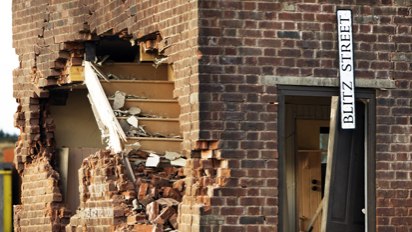Excerpts from http://www.channel4.com/programmes/blitz-street/articles/history-of-the-blitz

TUESDAY 16 MARCH 2010
An overview of the Blitz.
Strategic bombing during World War II was greater in scale than any attack the world had previously witnessed. The Blitz ('Blitzkrieg', or 'Lightning War') was a sustained bombing campaign intended to break the will of the British people in advance of a German invasion. It targeted Britain with a combination of ever more powerful bombs, incendiaries, doodle bugs and V2 rockets.
The Nazi bombing of London began in the late afternoon of Saturday 7 September 1940. In the next nine hours, 348 German bombers escorted by 617 fighters dropped 600 tonnes of high explosives on the docks and East End. The planes formed a 20-mile wide block of aircraft filling 800 square miles of sky. By the next morning, 448 Londoners were dead.
And that was just the start. There followed 57 consecutive nights of relentless aerial bombardment. The only respite came when the Germans began to turn their attention to other British towns and cities too. On the night of 14-15 November, for example, 449 German bombers dropped a staggering number of high explosive bombs and incendiary bombs on Coventry, destroying 50,000 buildings, killing 568 people and seriously injuring over 1,000 more.
The incendiaries created terrible firestorms, with fierce winds sucking in air and fanning huge sheets of flame. On the night of 29-30 December, a devastating attack on London created a massive firestorm around St Paul's Cathedral. The image of the cathedral surrounded by flames and dark smoke immediately became a potent symbol of London's battle for survival.
The worst individual bombing incident of the Blitz occurred when an air raid shelter in a school in West Ham sustained a direct hit. Four hundred and fifty people were killed. The worst night of the Blitz was on 10-11 May 1941, when the German air force, the Luftwaffe, carried out one of the biggest raids of the war, leaving more than 3,000 people dead. It was, however, the Nazis' parting shot as the Luftwaffe was then transferred to eastern Europe in preparation for Hitler's invasion of the Soviet Union.
In all, more than 20,000 Londoners lost their lives during the Blitz. In the country as a whole, 18,629 men, 16,201 women, and 5,028 children were killed, together with 695 others who bodies could not be identified. Up to the end of 1941, more British civilians had been killed on the home front than British soldiers on the battlefield.


No comments:
Post a Comment